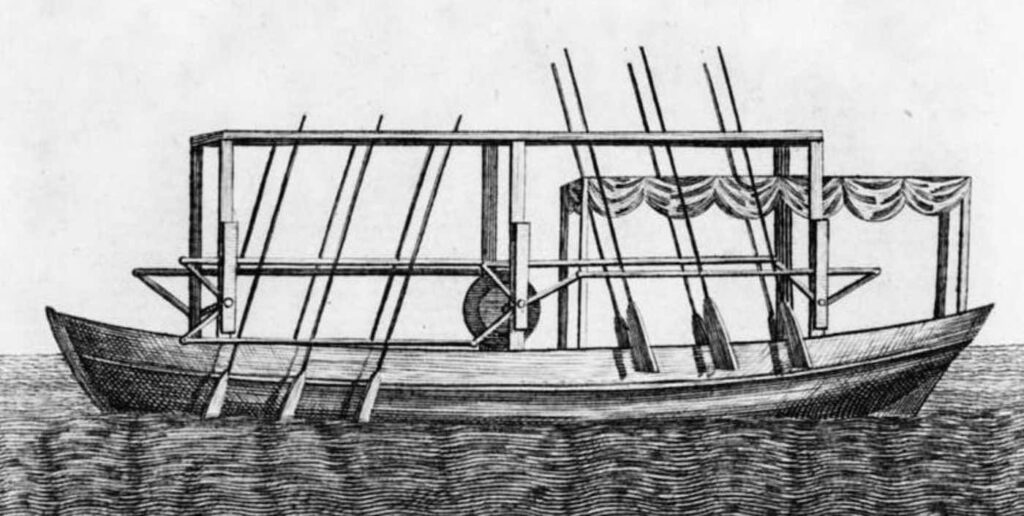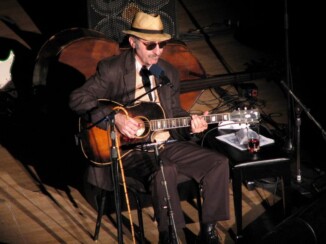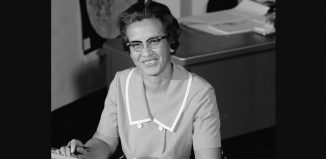233 years ago today, John Fitch was granted a US patent for a boat propelled by steam power which used mechanical paddles to propel it atop lakes and rivers—an invention that revolutionized commercial transportation of both passengers and freight. The American inventor, clockmaker, silversmith, surveyor, entrepreneur, and engineer, also provided beer, rum, and other supplies in 1778 to General Washington’s troops at Valley Forge. READ more about the first steam ship and its inventor… (1791)

He first tested his steam-powered concept using a 45-foot-long boat on the Delaware River, and he soon was operating the first steamboat service in the U.S., carrying up to 30 paying passengers between Philadelphia and Burlington, NJ. His improved designs produced a 60-foot (18 m) boat powered by a steam engine driving several stern-mounted oars that paddled akin to a swimming duck’s feet.
Decades later, he built a model of a land-operating steam engine meant to operate on tracks—envisioning the first steam locomotive. However, he never achieved success in his lifetime due to financial and patent disputes. But his legacy is honored in museums, memorials, and schools in several states, and a published book.
MORE Good News on this Day:
- Michelangelo was commissioned to carve the Pietà (1498)
- Liberia was proclaimed an independent republic (1847)
- Albert Sabin, the Polish-American doctor who developed the polio vaccine that would block the virus from the bloodstream and break the chain of transmission, was born (1906)
- Mother Teresa, the Nobel Peace Prize-winning Albanian Catholic nun who made it her life’s work to care for the sick and poor in India, was born (1910)
- The 19th Amendment to US Constitution took effect, giving women the right to vote (1920)
- Major League Baseball was televised for the first time, a game between the Cincinnati Reds and the Brooklyn Dodgers at Ebbets Field on W2XBS (1939)
- Sigmund Jähn became first German cosmonaut, on board Soyuz 31 (1978)
- In a pioneering operation in Britain, the world’s first battery-operated ‘bionic’ heart, a titanium and plastic device manufactured in America, went to a 62-year-old who had only months to live (1994)
- Russia recognized the independence of the former Georgian breakaway republics Abkhazia and South Ossetia (2008)
- Kate Bush made her stage comeback in a London theater to ecstatic fans at her first live concert in 35 years, the first of 22 shows which had completely sold out in less than fifteen minutes (2014)
On this day in 1949, jazz singer Leon Redbone was born in Nicosia, British Cyprus. As American as one might perceive Redbone as being through his crooning voice and down-home guitar, his real name was Dickran Gobalian, owing to his Armenian ancestry. A real musical renegade, Redbone was a self-taught musician, who played by ear, sometimes changed the chords of established tunes, never rehearsed with a band, and didn’t follow setlists.

Redbone usually dressed in attire reminiscent of the Vaudeville era, performing in a Panama hat with a black band and dark sunglasses, often while sitting at attention on a stool.
For much of his career, he had a reluctance to discuss his past, and his true name and place of birth only became available later through demographic research. It gave rise to speculation that “Leon Redbone” was an alternative identity for another performer.
Two common suggestions in years past were Andy Kaufman and Frank Zappa. Though sometimes compared to Zappa and Tom Waits for “the strength and strangeness of his persona,” he almost exclusively played music from decades before the rock era, occasionally writing his own new material in a similar blues-influenced Tin Pan Alley style.
Mystery followed him everywhere. He miraculously survived a plane crash in West Virginia in 1979, after which he traveled exclusively by car. However, when asked about it, he responded “I carry around many unusual items and devices. They make life difficult for airport security personnel and flying impossible for me.”
A clarinet player who toured with Redbone described him as having the most eclectic music taste of anyone he had ever met, spinning records in his downtime of Italian virtuoso violinist Niccolo Paganini, ragtime blues man Blind Blake, early Bing Crosby, and Mongolian throat singers, sometimes one after the other. (1949)
246 years ago today, a group of men summited Triglav for the first time; the preeminent symbol of Slovenia, and the centerpiece of that country’s only national park. At 9,395 feet, (2,863 meters) it is not only the highest mountain in Slovenia but the highest peak of the Julian Alps. Surgeon Lovrenz Willomitzer, the chamois hunter Štefan Rožič, and the miners Luka Korošec and Matevž Kos, made it to the summit for the first time in recorded history according to reports at the time.

Known as the Tricorner, the mountain is on military badges, 50 euro cent coins, and the mountain’s three distinctive peaks were used as inspiration for the triglavka, a three-humped hat worn by Slovenian partisans in World War II.
There is also an old Slovene folk tale concerning a hunter seeking a treasure guarded by an enchanted chamois buck named Zlatorog (‘Goldhorn’, after its golden horns). (1778)
Happy 54th Birthday to Melissa McCarthy, the comedic actress, writer, and producer from Illinois.
She won an Emmy for co-starring in the sitcom Mike & Molly (2010–2016)—and a second as guest host on Saturday Night Live, and gained critical acclaim for her performance in the film Bridesmaids (2011), with an Academy Award nomination for Best Supporting Actress.

McCarthy and her comic husband Ben Falcone are the founders of the production company On the Day Productions, under which they have collaborated on several comedy films. In 2015, she launched her own clothing line for plus-sized women, named Melissa McCarthy Seven7, although a couple years later she lost a lot of weight. After starring in a string of commercially successful comedies, including Identity Thief, The Heat, Tammy, St. Vincent, Spy, and The Boss, McCarthy expanded into dramatic roles in 2018 by portraying Lee Israel in the biographical film Can You Ever Forgive Me?, earning a nomination for the Academy Award for Best Actress. WATCH her AARP interview… (1970)
And, on this day in 1918, the African-American mathematician Katherine Johnson was born. Her calculations of orbital mechanics at NASA were critical to the success of the first U.S. manned spaceflights. The Oscar-nominated film Hidden Figures honored her genius in 2016 with actress Taraji P. Henson portraying the young Johnson’s reputation for brilliantly forecasting flight trajectories using complex manual computations. Her leadership helped to establish confidence in the use of computers to perform the same tasks, yet astronaut John Glenn refused to fly unless Johnson manually verified the computer’s numbers.

The West Virginia math prodigy graduated from high school when she was just 14 years old, and her college, West Virginia State, had to add new math courses just for Katherine. At NASA, which was still racially segregated at the time, her knowledge of analytic geometry helped make quick allies of her white male bosses. She worked out rendezvous paths for the Apollo lunar lander on flights to the Moon and, later her calculations were essential to launching the Space Shuttle program. While the racial and gender barriers were always there, Katherine says she ignored them, and never really felt them. She was assertive, asking to be included in editorial meetings (where no women had gone before). She simply stated that she had done the work and that she belonged… There is even a Barbie doll based on the female role model. WATCH a wonderful clip from the movie…
And, on this day in 1789, the Declaration of the Rights of Man and of the Citizen was approved in France by the Constituent Assembly as the founding document of the French Revolution. The Declaration was drafted by the Abbé Sieyès and the Marquis de Lafayette, in consultation with Thomas Jefferson, and it states, like the US Declaration that came before it, “Men are born and remain free and equal in rights.”
With this document, the rights of the French people were held to be universal: valid at all times and in every place, pertaining to human nature itself. It became the basis for a nation of free individuals protected equally by the law.
SHARE The Milestones, Memories, Movies, and Birthdays…





















[…] By Good News Network […]
[…] By Good News Network […]